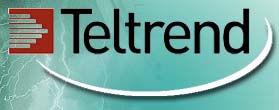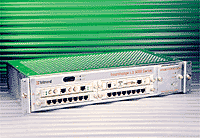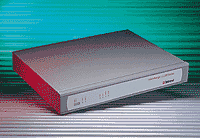We are unable to perform any repairs to Teltrend products. Neither can we supply or advise upon ISDN protocol conversion products.

"We make incompatible systems compatible".
Teltrend Limited is the acknowledged leader in the design and manufacture of protocol interworking systems for the telecommunications industry. This experience is gained from more than a decade of providing solutions for public network operators world-wide. Teltrend's InterChange iQ range of products provide signalling protocol interworking, transparency, port/bandwidth concentration and grooming. These are managed by Vision iQ, an element management system, as part of total managed access network solutions. Teltrend's solutions allow operators to build on their existing investment in infrastructure by enabling previously incompatible networks to inter-operate and inter-work.
(This section was paraphrased from the Teltrend website)
We were involved with Teltrend from June 1998 until June 2000, designing software for a number of protocol conversion products.
We designed a high level diagnostic facility for incorporation into a number of Teltrend products.
The Call Tracing service was designed to provide a generic mechanism for on-line diagnostic tracing whereby call interactions could be retrieved at various levels of detail, with a guarantee of long-term data retention for “hung” calls, even under high overall traffic loads. It was intended to be used primarily by support personnel in the event of the customer reporting problems with calls not completing satisfactorily. It could be operated remotely, or locally via a connected management terminal.
The call tracing software was designed so that it could be added to existing protocol stacks with minor alterations. Provision was made to handle a variety of stack types: those controlling a single ISDN interface as well as those controlling multiple interfaces. Voice, data and virtual calls were supported.
The layer 3 tasks passed information to the call tracing subsystem upon the transmission or reception of messages to / from the line. The data was stored in a circular log, with each message annotated so that the layer 3 events could be retrieved, if still stored, by line, channel, call type, time period, called / calling party number or other criteria.
The call tracing service was controlled by a PC-based external management system. This allowed the operator full control over which calls were stored in the log and which messages were retrieved for examination. Remote operation was possible via a modem.
The task was designed to run on the Teltrend proprietary multi-tasking operating system. The design process required detailed knowledge of the existing product software architecture. It was coded mainly in C, but with some Pascal elements so that it could interface to other software subsystems written in Pascal.

The InterChange iQ 5000 was initially designed to perform primary rate to basic rate conversion. Whilst the primary rate ports operate Euro-ISDN, DASS2, DPNSS or Q.SIG, the basic rate ports deliver Euro-ISDN. Housed in a 19 inch rack for installation in a street cabinet, the unit is designed to operate on the boundary of the Access Network.
The product was adapted to provide three primary rate conversions for a particular customer. Software was written that allowed Q.Sig messages to be sent transparently across a Passport network.
We wrote software to add alarm propagation and other management features to the product.

The InterChange iQ 200 was developed to provide signalling conversion between disparate ISDN protocols, such as DASS to DPNSS or Euro-ISDN (Q.931). Designed to perform the signalling conversion function at the boundary between the user equipment and the public network, or between private networks, the InterChange iQ 200 overcame ISDN compatibility issues for a wide range of Customer Premise equipment. However, the product was based upon obsolete 68010-based hardware, using software that was quite different from the mainstream Teltrend products.
We were tasked with porting the software to run on new 68360-based hardware. The software had to cater for the different hardware environment and it had to be brought up to the latest standard with the latest bug fixes and features, which involved modifications to almost every subsystem. It required detailed knowledge of the software architecture, together with in-depth debugging skills.
In the UK, the market for networked PBX's is dominated by vendors supplying DPNSS based networks. This is in spite of the availability of more modern alternatives based on more advanced technology and supporting an international networking signalling System, Q.Sig.
Teltrend's products allow DPNSS PBX's to be connected to a Q.Sig network, allowing the full functionailty of the PBX to be maintained, using protocol interworking technology.
Protocol interworking preserves full support of advanced supplementary services between switches/PBXs operating two different protocols. This operates by converting the signalling of one protocol into primitives, and then converting these into the second protocol.
Protocol Transparency enables a complete protocol to be transparently transported across an intervening private network operating a different protocol. This enables 'seamless' operation between switches/PBXs using the same protocol via an intervening network.
(This section was paraphrased from the Teltrend website)